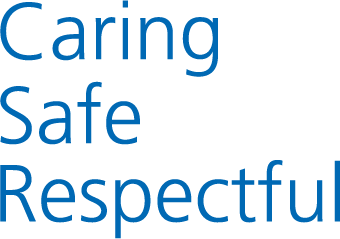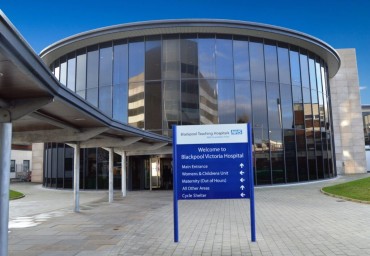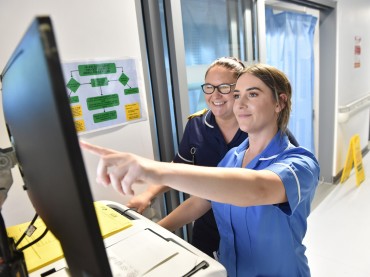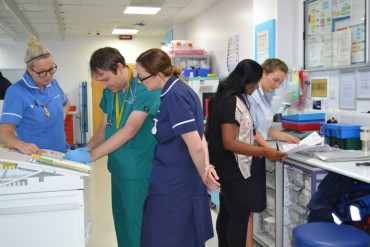What to expect from your stay in hospital
You have been admitted to the Ward for a Thoracoscopy (V.A.T.S. – Video Assisted Thoracoscopic surgery).
This leaflet will explain about the operation, why and how it is normally done and any risks involved. It will also explain about the care you will need after the operation. If you have any further queries or worries please do not hesitate to ask the Doctors or Nursing Staff. The Staff on the Ward are always available to answer any questions you may have.
You will meet your surgeon at an outpatients appointment where they will discuss the type of surgery you require, what the surgery involves, the risks and benefits and any alternate treatment available.
Thoracoscopy is the name given to the procedure that the Surgeon performs to insert a small tube with a camera attached into the chest to look directly at the lung or lung cavity. This procedure may be performed for various reasons depending on your medical condition.
VATS is commonly known as keyhole surgery. The incisions during this procedure are much smaller than the traditional approach and do not involve spreading the ribs. The advantage of VATS over thoracotomy is that it involves smaller incisions, this leads to reduction in the duration and intensity of post operative pain and allows patients to return to their normal activities a lot quicker.
The following are procedures that are commonly performed via Thoracoscopy. The Doctor or Nurse will be able to explain which procedure applies to you.
1. VATS Lobectomy Your lungs are divided into lobes, with two lobes on your left side and three on your right lung. A VATS lobectomy is an operation where one of the lobes is removed.
During the VATS lobectomy the surgeon will make three small cuts on your chest about 2–4 cm long. One cut will be for the instruments to perform the operation. Using a stapling device, the surgeon will separate the lobe of the lung from the rest of the lung. The lobe will then be put into a sealed bag and removed through the cuts in your chest. Two of the cuts will be closed with dissolvable sutures and the other is used for a chest drain, which drains any air and fluid after the surgery. The length of time that these drains need to stay is dependant upon the procedure that you have had and the Surgeon’s requirements. The lobe of the lung is then sent for analysis which can take between 7–10 days.
2. Biopsy – the Surgeon will collect samples from the area inside the chest as required and these can then be sent for analysis. Biopsy results can take 7 – 10 days and if you have been discharged from hospital they will be sent to your G.P. and your referring Consultant
3. Pleurodesis – this is performed when the lung deflates (a Pneumothorax), this is usually the result of small cysts (bulla) bursting and causing air to escape from the lung into the surrounding cavity. This is similar to a puncture in a tyre. The Surgeon can help this to heal by creating a rough surface on the lining of the lung – this helps the lung remain inflated. It can also be performed to prevent the accumulation of fluids building up in the chest cavity.
4. Pleurectomy – the Surgeon can remove the sac surrounding the Lung (pleura) this is usually to prevent the recurrance of a Pneumothorax.
5. Stapling of Bullae – this is again a procedure for a Pneumothorax in which the cysts are excised when they have burst.
6. Wedge resection of lung – this is done for various types of surgery on the lung which includes surgery for a nodule and doing a biopsy on the lung. Other procedures can be performed using a VATS approach on both the chest and heart. VATS is possible in most procedures and it will be explained to you by your Consultant. It is also important to understand that in certain circumstances it becomes necessary to change the plan of surgery and extend the incisions and spread the ribs to do the surgery whilst you are under anaesthetic.
With any surgical procedure, there are risks attached. The risks will be individual to you and your surgeon will explain these to you.
Conversion to open operation
For technical reasons the surgeon may be unable to do your operation via the VATS method so may have to convert to an open operation (thoracotomy).
Sore throat
It is normal to have a sore throat from being anaesthetised, this should settle in a few days.
Damage to teeth
Teeth can occasionally be damaged from the anaesthetic and broncoscopy instruments. All the staff will try very hard to prevent this. Please ensure you let the doctors know if you have any loose teeth, caps or crowns.
Coughing up blood
It is normal to cough up a little blood for the first few days after lung surgery. The nurses and physiotherapists will help with breathing exercises after your surgery to clear this. It will gradually get less over time.
Chest Infections
This occurs in about 5% of patients having VATS lobectomy. Physiotherapy, early mobilisation and adequate pain relief can help reduce the risk. If you do develop a chest infection you may need treatment with antibiotics which may result in you staying in hospital for a few extra days.
Pain
It is normal to have pain after this operation. Regular pain relief will be given to control the pain and it should settle in a few weeks. Very occasionally pain does not settle. If this is the case you may need to see a specialist at a pain clinic.
Bleeding
Following lung surgery some blood loss into your chest drains is normal. A small percentage of patients having a VATS lobectomy will need to return to theatre to control the bleeding.
Wound infection
Showering in an antiseptic solution before your surgery, frequent hand washing and using the alcohol hand gel provided helps to prevent this risk. A small percentage of people having this surgery will develop a wound infection requiring antibiotics and wound dressings. This may involve district nurse input following your discharge.
Empyema
This occurs rarely and is an infection between the lung and the chest wall and will require longer term drainage.
Blood Clots
These can occur in the legs and then travel to the lungs. The risk is greatly reduced by wearing support stockings, Flowtron boots, having daily injections of a blood thinning drug and early mobilisation.
Faster heartbeat
This can occur following lung surgery and may be treated with drugs to slow the heart rate down.
Air leak
This is when the cut surface of the lung leaks air and is a frequent occurrence following lung surgery. It usually settles within a few days but will mean that the chest drain has to stay in your chest until it settles. If it is taking longer to settle you may be discharged home with a drain in to come back to the ward weekly for review.
Pneumothorax
Occasionally the remaining lung will not fully inflate following your surgery and so may mean having the drain for longer. Sometimes once the drain is removed your lung may partially collapse. This will either resolve itself or occasionally require a new drain to be inserted.
Heart attack or stroke
This can occur during or after surgery. The risk is higher in patients with a cardiac history or undiagnosed cardiac disease. For this reason you may require to have extra investigations and a full assessment prior to your surgery.
Disorientation
Some patients whist recovering from surgery might be disorientated on the ward and the people around them. They may behave differently than normal and temporarily have loss of memory. This is often a reaction to the anaesthetic drugs and the strong pain relief you are given.
Risk of death
Any surgery carries a degree of risk and this can include a risk of death. The risk will vary for each patient. Your surgeon will discuss specific risks that apply to you. Please remember you can ask any questions and voice any concerns at any time to the doctors and nurses looking after you.
The preparation –
you will be seen in a Pre-Admission Clinic for routine tests such as Chest X-ray, E.C.G. (heart tracing), blood tests and possibly lung function tests (breathing tests). The nurse / doctor will also want know about your past medical history and any operations you have had and also if you have any allergies. They will discuss with you your plans for discharge and you will be expected to arrange care for yourself when you go home.
The length of time you will be in hospital depends upon your condition and the Surgeon will be able to give you guidance on this.
When the Consultant saw you in clinic and advised that you needed an operation he will have advised you to stop smoking from that time. This is very important as your recovery can be prolonged if you continue to smoke. It may help you to contact the NHS. Quitline.
The Surgeon or one of the team will explain the operation to you and you will be asked to sign a consent form. You must be satisfied with all the details given and fully understand them before signing the consent form – this is to ensure that you understand the operation and its possible complications. If you have any queries, please do not hesitate to ask the Doctor or Nurse.
Please take your medication or a list of medication and the times that you take them with you to your pre-admission appointment and on the day that you go into hospital.
You will also see the Anaesthetist who will assess you for the anaesthetic. They will discuss the different types of pain control that are available following your surgery as there are a variety of options. It is natural to worry about pain and how you may cope after surgery; our understanding of controlling pain has improved over the last few years!
If you have attended the preadmission clinic you will likely be admitted on the morning of your surgery either at 7am or 9:30am. You will be contacted the afternoon before your planned surgery to reiterate the plans for your surgery including when you need to starve from (you can drink tap water prior to your surgery). The Same Day admission area is situated just outside Ward 37. It is a seated area with separate areas for male and females. You will be shaved and asked to have a shower using an antiseptic soap wash before being put in your theatre gown and a pair of anti-embolism stockings which help in the prevention of clots. A member of your family can stay with you until you go to theatre.
When it is time to go to Theatre your details will be checked and you will be escorted there by a Nurse and a Porter.
If you are coming in the day before your surgery you will be phoned about 1pm that day and asked to come in at a specific time to either Ward 38 or 39 who will then continue your treatment as above.
The nurse escorting you will hand over your care to one of the Theatre Nurses in the Theatre’s anteroom, who will check your details again. You will then be taken to the Anaesthetic room where the Anaesthetist will administer your anaesthetic, from this point you will be aware of nothing until the operation is over. After the operation the Anaesthetist will wake you up and you will be placed in your bed in the Recovery Room. When the Anaesthetist is satisfied with your condition he will allow you to be transferred either back to the Ward or to the Cardiac Intensive Care Unit if you require closer monitoring.
A padded dressing will cover your wound. Whilst you are not eating and drinking an infusion of clear fluids will be given to you via a needle going into one of your veins. You will also have an oxygen mask over your nose and mouth for at least 4 hours. You will also have one or more chest drains in place that are attached to drainage bottles.
You will probably be very drowsy and because of the anaesthetic you cannot eat or drink for four hours after the operation. After this you will be given a drink of water initially and then, when you can tolerate this you will be given something to eat and a cup of tea. You may feel sickly after the surgery and the Nurse will be able to give you some medication that should stop this.
During the first few hours the Nursing Staff will keep a close check on your recovery by taking your blood pressure, pulse, temperature, respiration rate and oxygen saturations. They will also observe your surgical wound and record any drainage from the chest drains. Your pain score will be assessed to ensure that you are as comfortable as possible. The staff will also ensure that you pass a good amount of urine (If you have an Epidural for your pain management you may have a urinary catheter draining from your bladder). Most patients are nursed in a semi-sitting position supported by pillows to assist you with your breathing. The Nursing Staff can liaise with the pain management team if there are any problems with your pain control.
Enhanced Recovery After Surgery (ERAS)
At Blackpool teaching hospitals NHS foundation trust we aim to provide high standards of care based on current recommendations and protocols. The E.R.A.S. programme provides daily goals to achieve. Please remember that these goals are set to be worked towards, but everyone is an individual and will achieve these goals at different levels.
The following morning you will be allowed to have a light breakfast. The Doctor will come and review your progress. They may require you to have a Chest X ray and blood tests. The X ray may be performed at your bedside – this is dependant on your surgery and condition.
The Nursing Staff will assist you with your hygiene needs and they will help you get out into a chair if you are following the ERAS programme you will already have been in your chair on the day of surgery
You may be seen by a physiotherapist following your surgery depending on the operation performed. You will be expected to sit out in a chair and stand or march on the spot regularly during the day. If you have a portable chest drain (Thopaz) the team will aim to walk with you on the day following your surgery. The physiotherapist will teach you deep breathing, coughing and upper/lower limb exercises. It is important to regularly deep breath and cough to keep your chest clear. You may be given a spiro/ coach to help you deep breathe. Although it may be sore to deep breath and cough – you will not cause damage by doing this. Early mobilisation is encouraged as soon as possible.
As your condition improves the drain (s) will be removed and you will gradually resume full mobility and independence before you are ready for discharge. If you wish you may wear your own clothes such as tracksuit, shorts and t-shirt.
You can have a bath or shower once the drains are removed.
Some patients have to keep their drains in for longer if there is still some air leaking from the area of the lung that has been operated on. On occasions patients are discharged home with a drain in which allows them to be fully independent and mobile. In these circumstances you will be asked to come back to the ward for regular checks whilst the drain is in place to see the Thoracic Specialist nurse who will remove your drain when the leak subsides and your lung is fully inflated.
Stockings
You will be required to wear anti-embolism stockings after your procedure. The length of time that you have to wear these will be depend on what procedure you have had done, so please discuss this with the nurses on the ward.
Your Consultant or the Registrar will assess your condition and when they are satisfied with your recovery they will give you a proposed date for your discharge. This will either be to your home or for any continuing care you have arranged for yourself. During your recovery you will be able to plan for your discharge with the input of the Nursing Staff and your family.
After your surgery you will need someone to be at home with you for the first few days. For the the first few weeks you will require help with heavier housework such as hoovering, changing the bed, shopping or mowing the lawn. Family and friends are often willing to help so please ask them and accept their help. However if you live alone you will need to contact your local social service department or practice manager at your GPs surgery to see if there is any help available to you in your local area. Unfortunately convalescence beds are no longer easily available and can lead to delayed discharges .
You may require a sick note for your stay in hospital and for your period of convalescence so please remember to ask the Nursing Staff to arrange this for you.
The Nurse discharging you will give you enough medication for at least seven days; they will also explain the medication, dosage, frequency and continued administration. You will also be given a letter for your G.P. which will explain the surgery that you have had and also the medication you have gone home with.
Any chest sutures (stitches) you have will either be removed prior to discharge or the Nursing Staff will advise you to go to your local medical centre to remove them.
We ask that someone collects you from the Ward.
Advice about follow up appointments that you need to attend will be given.
PAIN – pain will be managed by oral analgesia (painkillers). Painkillers should be taken, if needed, for pain, discomfort or soreness. Don’t be a martyr and try to put up with any pain – it may make you feel miserable and may stop you from doing your deep breathing exercises efficiently. If you find that the painkillers you have been given from the Ward are not sufficient please contact your G.P.
BREATHING – If provided with a spiro you can take this home with you and continue to use it at home. Your physiotherapist or nursing staff will provide guidance on how often to use it at home. Monitor your sputum production – if this is increasing in quantity or changing in colour you may have a chest infection. It is important that you then contact your G.P. for advice. Do not smoke and avoid smoky atmospheres. You can continue to use a towel to support yourself whilst coughing. You may experience some shortness of breath during activities. This is often normal following thoracic surgery and should improve as you recover. It can take 4-6 weeks to recover to your pre-op exercise tolerance. If you become short of breath at rest or find that your breathlessness is not improving this can be a sign of a chest infection and you should contact your GP for advice.
DRIVING – returning to driving is related to what operation you have had done, so the advice varies for each individual but you are normally covered to drive again after 4 weeks unless told otherwise on discharge
SLEEP AND REST – It is common for patients who have had surgery to feel extremely tired, both when they are in hospital and upon discharge. This is normal and should be the limiting factor to your progress. Try to take a nap in the afternoon as you did on the ward for an hour or two, or go to bed early in the evening.
HOLIDAYS – As a general rule most people are able to go on holiday, either abroad or in this country, approximately 10 to 12 weeks after surgery. Under normal circumstances you should be able to fly by then.
You will be sent an appointment through the post, approximately 6 to 8 weeks after your hospital discharge, for a post-operative check.
You will be contacted during your first week at home by the Thoracic Specialist nurse . If you have any problems or worries before this call they can be contacted on on 01253 300000 and ask for bleep 285 or leave a message on 01253 957718.
It is hoped that you find the information in this booklet helpful. If you have any problems following your discharge from hospital or these guidelines are unclear and do not answer your particular query, firstly contact your G.P. Or if they cannot help ring the ward that you were on as a patient.
Author Bernie McAlea
Leaflet PL/868
Review Date 01/09/2026



